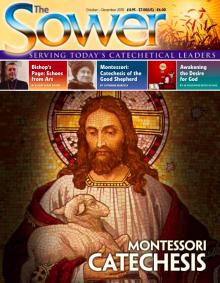Montessori’s name is associated with a teaching methodology for children that is particularly attuned to their needs and capacities. We might wish to take this thought as a springboard for how God provides for us as his children, with the provision of a catechetical environment enabling us to receive all that we need for our growth as his free sons and daughters.
Taking the catechumenal model for adults as the focus for our understanding, as indicated by the General Directory for Catechesis, we can note that the catechumenate – the intense period of organic, systematic and comprehensive catechesis - is described as an ‘initiatory’ process leading to our ‘(re)birth’ in the waters of Baptism. We are ‘born’ in Baptism. But even before the candidates ‘come to birth’ in Baptism, during this period of catechesis, catechumens are ‘already joined to the Church, they are already of the household of Christ, and are quite frequently already living a live of faith, hope and charity’[i]. ‘With love and solicitude mother Church already embraces them as her own’.[ii] This is the period of initiation, which lays ‘the foundations of every Christian life’.[iii]
Formed in the womb
Through this imagery, it is indicated that we might profitably think of the period of the catechumenate as a period in the womb, as a period during which the life that is growing within the womb of the Church is provided with all that is needed for his or her life in the world. All that is received is given through the mother, and therefore it is easy to understand why the Church is so often described as mother and teacher, for it is in this period that the Church teaches most intensively. The catechumenate is to be ‘a formation in the whole Christian life…during which the disciples will be joined to Christ their teacher’.[iv] Through the Church’s catechesis during this period the great limbs of doctrine are provided and are knitted together in the womb, the spiritual senses and capacities are awakened, nurtured and fed, while the growing child learns to be sensitive to the beat and rhythms of the mother’s heart and life. Following this analogy, then, we can understand the catechumenate as the great and vital period of growth, where everything is provided for Christian life.
Hiddenness
This is also necessarily a period of hiddenness, of protection from the world, because of the importance of seeing to the careful growth of each element of the intricate frame of the child. The body of the child is to be made a member of Christ’s living Body and must learn how to be joined to that Body. That which is in the womb of the Church, in this great school of growth in the faith, cannot be seen from outside.
It is after his Baptism that Jesus enters upon his public ministry. Until then we have what the Church calls the ‘hidden years’. The only event that breaks the silence of these years, says the Catechism, is the finding of Jesus in the Temple – the revelation that the growing child belongs to his heavenly Father.[v] The hidden years of Christ are the years when Mary ‘keeps’ the mystery of Christ in her heart. So, too, it is significant that the catechumenate is to be a protective period in which the inner growth of the candidates can be undisturbed so that they can blossom in their consecration to the mission to which God is calling them beyond their Baptism. The motherhood of new believers is a period of mystery.
Whole community
Just a mothers require the support of the whole community if they are to guard and nurture the growing life of the child, so catechists need the conscious support of the whole Church for their work of transmission of all that catechumens need for their new life. ‘Catechesis is intimately bound up with the whole of the Church’s life’.[vi]
The motherhood of the Church continues, for the Church is always mother and teacher to us.[vii] And so we pray that
‘a true filial spirit toward the Church can develop among Christians. It is the normal flowering of the baptismal grace which has begotten us in the womb of the Church and made us members of the Body of Christ. In her motherly care, the Church grants us the mercy of God which prevails over all our sins, and is especially at work in the sacrament of Reconciliation. With a mother’s foresight, she also lavishes on us day after day in her liturgy the nourishment of the Word and Eucharist of the Lord.’[viii]
NOTES
[i] Vatican Council II, Ad Gentes 14, 5.
[ii] Vatican Council II, Lumen Gentium 14, 3.
[iii] CCC 1212.
[iv] Vatican Council II, Ad Gentes 14.
[v] See CCC 534.
[vi] John Paul II, Catechesi Tradendae 13.
[vii] The fact of infant baptism means that there is the need for a post-baptismal catechumenate for ‘the necessary flowering of baptismal grace’ (CCC 1231), a post-baptismal period of intense teaching and protection in the ‘womb’ of the Church.
[viii] CCC 2040.
This article is originally found on page 4 of the printed edition.
This article is from The Sower and may be copied for catechetical purposes only. It may not be reprinted in another published work without the permission of Maryvale Institute. Contact [email protected]

















